 We have recently updated the Journal Profile Pages in MathSciNet to present the amazing information we have about the many journals Mathematical Reviews covers. Whenever possible, we offer graphical formats for the data, as well as tables. The Mathematical Reviews Database contains considerable information about the research mathematics literature. Consequently, the database contains considerable information about the research journals, which is now at your fingertips! All of the information from the previous journal profile pages is still available, but there is much more. And we have made the pages prettier!
We have recently updated the Journal Profile Pages in MathSciNet to present the amazing information we have about the many journals Mathematical Reviews covers. Whenever possible, we offer graphical formats for the data, as well as tables. The Mathematical Reviews Database contains considerable information about the research mathematics literature. Consequently, the database contains considerable information about the research journals, which is now at your fingertips! All of the information from the previous journal profile pages is still available, but there is much more. And we have made the pages prettier!
In what follows, I will highlight some of the new features. However, I also invite you to do some exploring of your own, since there are some new features that I will gloss over and seeing some of them on your own will be a lot more fun!
The basic information
The main bibliographic information about the journal is in the first card, labeled Journal Details. Here is an example, using the Proceedings of the London Mathematical Society. I have chosen this journal because it has just enough features to make the example interesting without having so many features to make it complicated.
Proceedings of the London Mathematical Society. Third Series
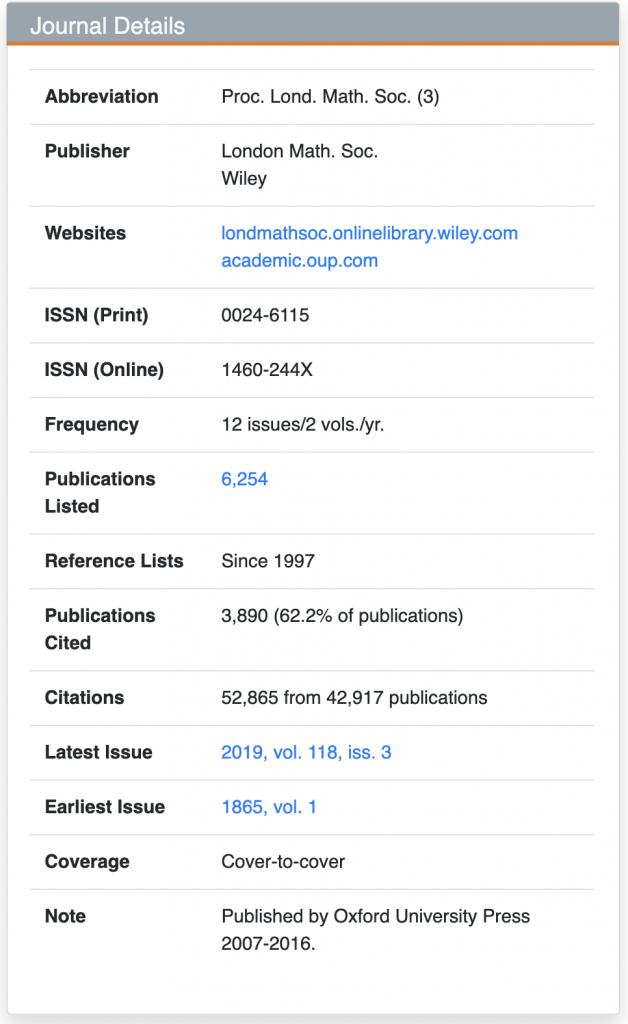
The title of the journal is at the top of the page. Some publisher information is at the top of the card, along with one or more links to the publisher’s website for the journal. The number after Publications Listed tells how many items (articles) from the journal have been included in the Mathematical Reviews Database and uploaded to MathSciNet. The number is actually a link that will take you to a listing of all 6,254 items, displayed as in the results of a MathSciNet publication search. The number for Publications Cited tells how many of the articles have been cited from the reference lists in MathSciNet. In this case, that number is 3,890, which is 62.2% of all the 6,254 articles we have for the journal in the database. The total number of citations in MathSciNet to Proceedings of the London Mathematical Society is 52,865. Apparently some of the items are receiving a lot of multiple citations! These 52,865 citations come from 42,917 items in the database. Since this number is smaller than 52,865, the pigeonhole principle tells us that some of these items are citing more than one article in Proceedings of the London Mathematical Society.
The Journal Details card includes information about the Latest Issue we have, including a link to the contents of that issue in MathSciNet. It also includes information about the Earliest Issue that we have in the database, including a link to the contents of that issue in MathSciNet.
The astute observer will have noted that the first issue listed is not from the Third Series of the Proceedings of the London Mathematical Society. Indeed, we have collected all the incarnations of the journal into a journal group. If you want to see the main constituents of the group, they are in the Concise History card. If a journal changes publishers or changes its title (from Second Series to Third Series, for instance), we catalogue that information. More details about the constituents, including notes on the changes from one to another, can be found by clicking the Journal Title History button in the Concise History card. See the note at the end of this blog post for a little more information about what is in the Journal Title History.
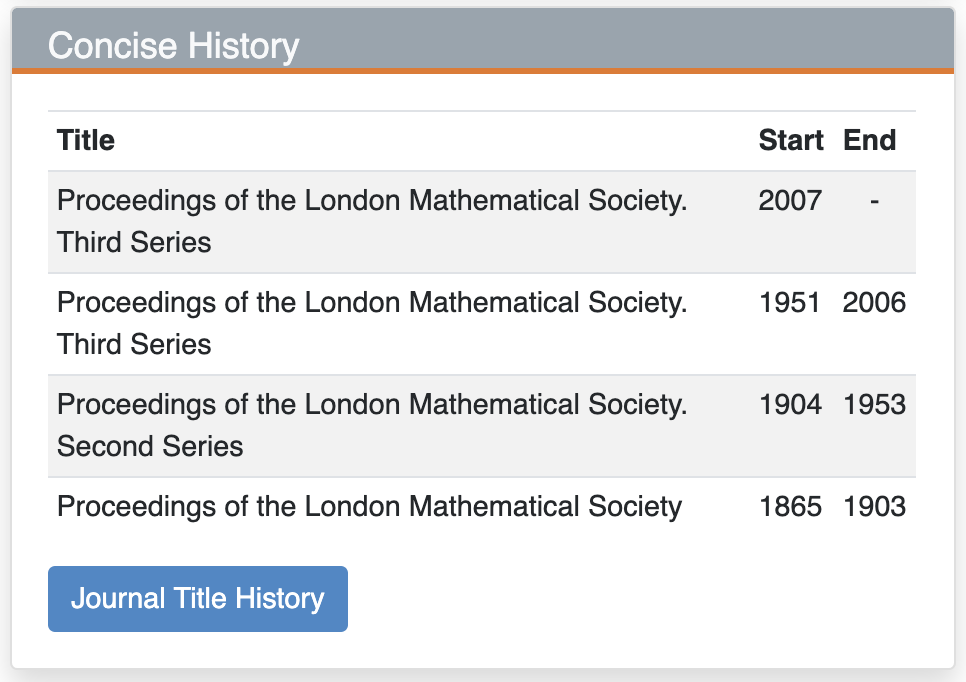
Mathematical Citation Quotient (MCQ)
The Mathematical Citation Quotient (MCQ) for a given year is defined as the number of times the items published in the journal in the previous five years were cited by items in reference list journals published in the given year, divided by the number of articles the journal published in that same five-year period. The All MCQ is the MCQ computed as if every item (every journal article, proceeding article, book, and thesis) had been published in one big journal. It provides a benchmark by which to understand the MCQ of a journal. In the new journal profile pages, the MCQ for each year can be seen graphically all at once, along with the All MCQ for each year. (Note that we don’t compute MCQs before the year 2000.) Here is the graphical representation of the MCQ data for the Proceedings of the London Mathematical Society.
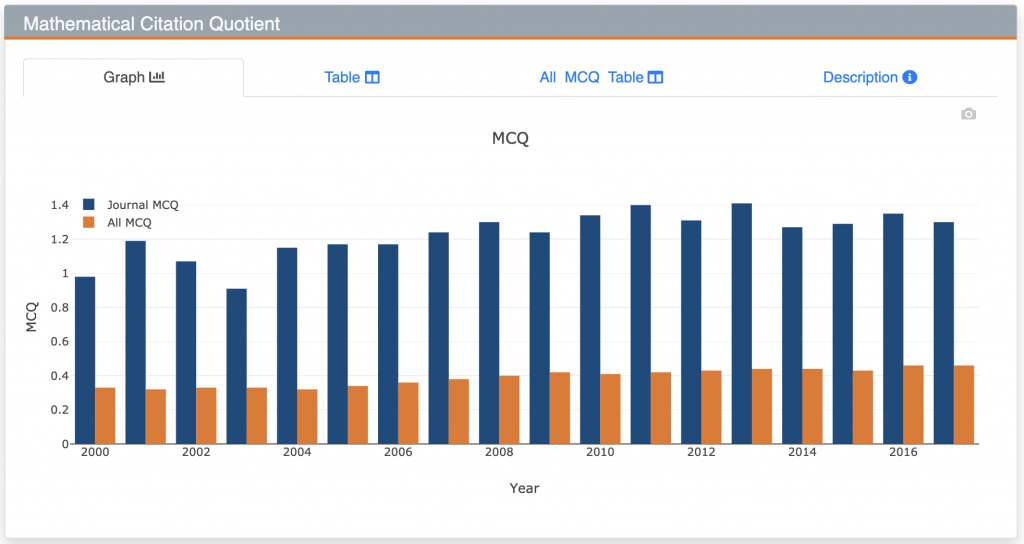
If you prefer numbers, clicking on the table tab provides the yearly MCQ data for the journal: the MCQ, the number of relevant citations, and the number of relevant publications in the journal. You can also see the table for the MCQ via its tab.
Pro Tip: In the bar graphs, clicking the small camera icon in the upper right-hand corner will download a PNG image of the graph to your desktop. For the tables, you can highlight the table to copy and paste to a text document or a spreadsheet.
Citations
This card presents data on the citations to the journal. The first tab shows a bar graph of the citations, broken down by the publication year of the cited papers. You can choose whether the citing articles have been published in a particular year or look at the data over all time. The default is to use all time. Change it by selecting a year from the Citation Year box and clicking Update. The horizontal axis shows the publication years for the particular journal. The default range of years is from 1990 to the present. However, if the journal started publishing after 1990, the graph is adjusted accordingly. There is a slider below the graph that allows you to adjust the left and right endpoints of the year range being displayed. Here is the bar graph for citations from articles published in 2017 to articles in the Proceedings of the London Mathematical Society in the year range 1900 to 2018:
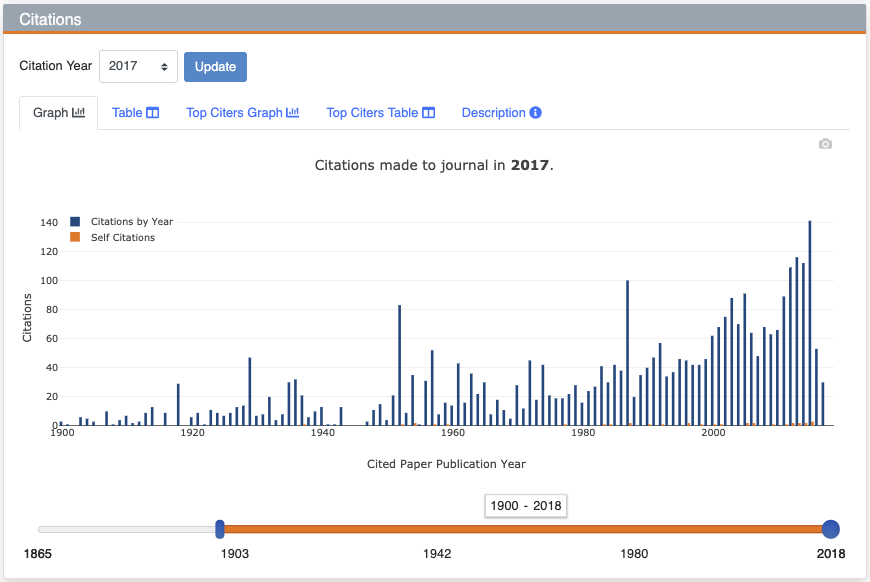
If you want to see the data in tabular form, just click Table. Here are the top few rows of the tabular form of the data in the above bar graph:
| Year | Citations by Year | Self Citations | Total Publications | % of Pub. Cited |
|---|---|---|---|---|
| 2017 | 30 | 0 | 67 | 77.6% |
| 2016 | 53 | 0 | 59 | 83.1% |
| 2015 | 141 | 3 | 89 | 93.3% |
| 2014 | 112 | 2 | 95 | 94.7% |
| 2013 | 116 | 2 | 86 | 96.5% |
| 2012 | 109 | 2 | 78 | 96.2% |
| 2011 | 89 | 1 | 64 | 98.4% |
| 2010 | 66 | 0 | 56 | 92.9% |
The last column tells you what percentage of the articles in that year of the journal have been cited in MathSciNet. You can have a year like 2010 where there are more citations than papers published in the journal, but still have 7.1% of the papers uncited. Clearly this means that some articles have multiple citations. The entries in the second and fourth columns are links. The links in the second column takes you to the citing papers as listed in MathSciNet. You may encounter a list of fewer items than the number of citations in the table, since it is possible for one paper to cite more than one article in the journal. In the results list, those papers are noted with the phrase “Multiple citations from this item to Proc. Lond. Math. Soc.” (using the abbreviated name of the journal in question). When you click through to the Proceedings of the London Mathematical Society Proc. are boxed. Note: The link specifies a particular publication year for the journal – citations to a different year of the journal will not be boxed.
Top Citing Publications
You can also see the journals that are citing this journal most frequently, either in a bar graph or in a table. Clicking on the name of the journal takes you to its Journal Profile Page. Here is the table for the Proceedings of the London Mathematical Society for the citing year 2017:
| Publication | Citations |
|---|---|
| J. Algebra | 102 |
| Adv. Math. | 100 |
| J. Math. Anal. Appl. | 59 |
| Trans. Amer. Math. Soc. | 53 |
| Proc. Amer. Math. Soc. | 49 |
| Comm. Algebra | 48 |
| Int. Math. Res. Not. IMRN | 41 |
| Math. Z. | 38 |
| J. Number Theory | 37 |
| J. Funct. Anal. | 31 |
Classifications
It is possible to see the distribution of MSCs (Mathematics Subject Classifications) in the journal, using either a three-year window or over all time. By default, just the top ten classes are displayed, but clicking Show All displays all of them. Here are the top ten for the Proceedings of the London Mathematical Society over all time:
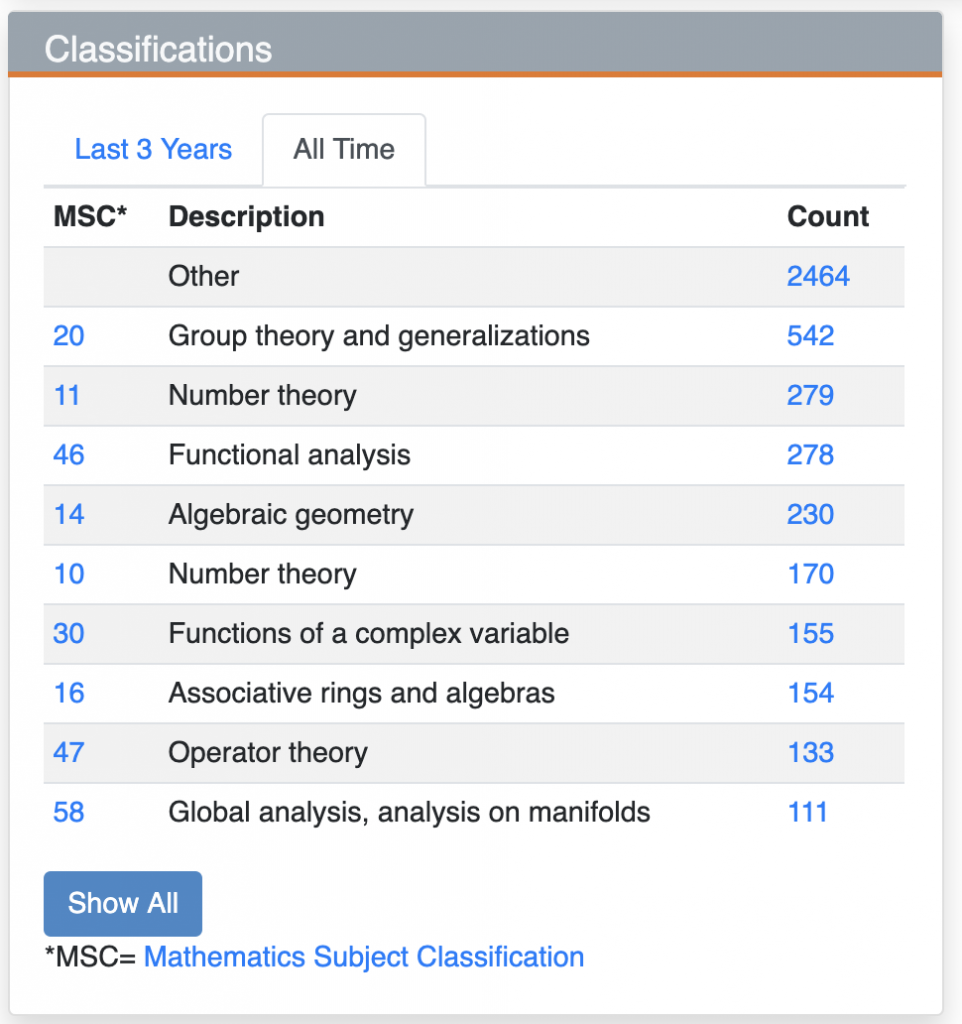
Notice that Other is the most common class that occurs. The Mathematics Subject Classification has not existed for as long as the Proceedings of the London Mathematical Society has been publishing. Indeed, the journal began publishing papers in 1865, before there was an American Mathematical Society and long before there was a Mathematical Reviews! We received bibliographic data from the journal that allowed us to back fill those years. The items that come from the contributed data do not have classes attached to them and are marked as Other. Clicking on the two-digit MSC brings you to a full description of the subject class. Clicking on the number in the Count column takes you to a listing of all the items in the journal with that class as primary class from the time period selected.
Authors
The last feature I want to point out is the table of the authors most frequently appearing in the journal. As with the MSCs, you can look either at the most recent three years or over all time. Here is the table for the Proceedings of the London Mathematical Society over all time.
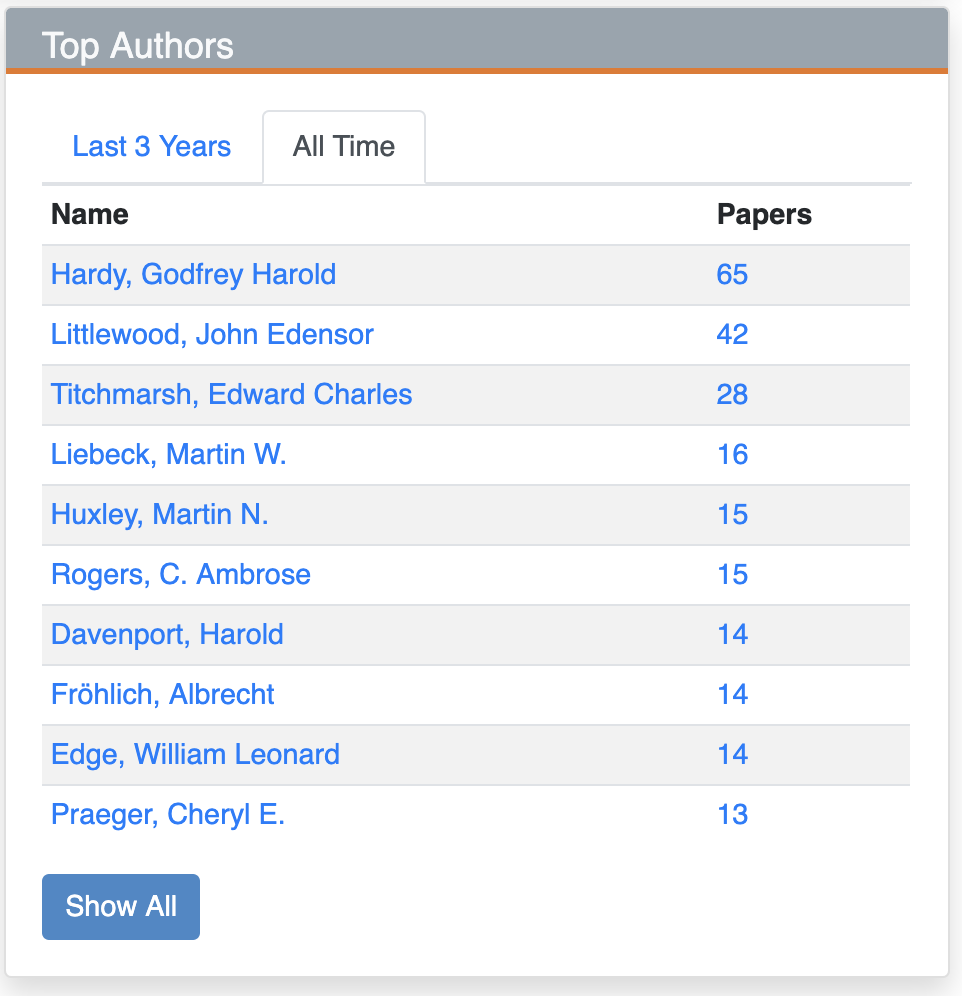
Clicking on the author’s name takes you to his or her Author Profile Page in MathSciNet. Clicking on the number in the Papers column takes you to the MathSciNet listing of the author’s papers in the journal.
I have skipped over a few things, but I hope they will be sufficiently self-evident. Besides, I don’t want to steal your enjoyment of discovering what’s new with the MathSciNet Journal Profile Pages!
Note on Journal Title History
For cataloging and bibliographic reasons, different incarnations of the same journal are distinguished in the database. For instance, a journal may change publishers, as the Proceedings of the London Mathematical Society has done a few times, starting off with Francis Hodgson, moving to Cambridge University Press, and now being published by Wiley. It is also possible that a journal changes its title, say from Bulletin of the American Mathematical Society to American Mathematical Society. Bulletin. New Series. Or, a journal may split, as Comptes Rendus Hebdomadaires des Séances de l’Académie des Sciences. Séries A et B did, creating three journals, including Comptes Rendus des Séances de l’Académie des Sciences. Série I. Mathématique. The new journal profile pages provide information on these transitions in the Journal Title History area. For foreign-language journals, the profile page has information about translations that are also covered by Mathematical Reviews.
Acknowledgments
The new Journal Profile Pages were created by Travis Smith and Erol Ozil. They were guided by the tremendous staff of Mathematical Reviews, who provided great suggestions and feedback. They had particular help from Kathy Wolcott and Norman Richert.
We had a prototype of the Journal Profile Pages at the Joint Mathematics Meetings in Baltimore (January 2019). We received valuable suggestions from quite a few mathematicians, librarians, and publishers at the JMM. Some of the librarians took extraordinarily close looks at the prototype and provided insightful comments. We are especially grateful for the time they devoted to helping improve the pages.
